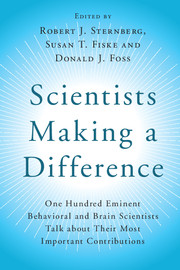 Scientists Making a Difference
Scientists Making a Difference Book contents
- Frontmatter
- Contents
- List of Contributors
- Foreword: Making a Creative Difference = Person × Environment
- Preface
- Part I Introduction
- Part II Biological Bases of Psychology: Genes, Brain, and Beyond
- Section A Feelings, Fears, Stressors, and Coping
- 2 Feelings and Decisions
- 3 My Career in Fear
- 4 Child Poverty and Brain Development
- 5 Try It and Assume Nothing
- 6 Coming Full Circle: From Psychology to Neuroscience and Back
- 7 Hormones, Epigenetics, the Brain, and Behavior
- 8 Brain Plasticity, Science, and Medicine
- Section B Cognitive and Social Neuroscience
- Section C Behavioral and Molecular Genetics
- Part III Cognition: Getting Information from the World and Dealing with It
- Part IV Development: How We Change Over Time
- Part V Motivation and Emotion: How We Feel and What We Do
- Part VI Social and Personality Processes: Who We Are and How We Interact
- Part VII Clinical and Health Psychology: Making Lives Better
- Part VIII Conclusion
- Afterword: Doing Psychology 24×7 and Why It Matters
- Index
- References
2 - Feelings and Decisions
from Section A - Feelings, Fears, Stressors, and Coping
Published online by Cambridge University Press: 05 August 2016
- Frontmatter
- Contents
- List of Contributors
- Foreword: Making a Creative Difference = Person × Environment
- Preface
- Part I Introduction
- Part II Biological Bases of Psychology: Genes, Brain, and Beyond
- Section A Feelings, Fears, Stressors, and Coping
- 2 Feelings and Decisions
- 3 My Career in Fear
- 4 Child Poverty and Brain Development
- 5 Try It and Assume Nothing
- 6 Coming Full Circle: From Psychology to Neuroscience and Back
- 7 Hormones, Epigenetics, the Brain, and Behavior
- 8 Brain Plasticity, Science, and Medicine
- Section B Cognitive and Social Neuroscience
- Section C Behavioral and Molecular Genetics
- Part III Cognition: Getting Information from the World and Dealing with It
- Part IV Development: How We Change Over Time
- Part V Motivation and Emotion: How We Feel and What We Do
- Part VI Social and Personality Processes: Who We Are and How We Interact
- Part VII Clinical and Health Psychology: Making Lives Better
- Part VIII Conclusion
- Afterword: Doing Psychology 24×7 and Why It Matters
- Index
- References
Summary
Writing about one's work is embarrassing, but the editors of this book have made the assignment easier by providing the authors with guiding questions. I will address them in the original order, as if I were answering questions in an imaginary interview.
What Do You Consider to Be Your Most Important Scientific Contribution?
I believe my best contribution has been the attempt to elucidate the nature of affective phenomena, in particular the collection of processes known as feelings and emotions. I have tried to understand these phenomena in psychological as well as neural terms, by placing them in the context of their likely evolutionary origin, immediate functional consequences, and ultimate implications.
Part of my contribution has to do with achieving some clarity regarding the definition of these phenomena, an indispensable part of scientific progress. This has not been easy because problematic definitions have hampered affect research beginning with William James, the genius creator of the field. For example, feelings and emotions are often thought to be one and the same thing, by specialists and by lay public alike, but they clearly are not.
Feelings are mental accounts of the state of life within the organism in whose mind the feeling occurs. In other words, feelings are mental portrayals of the myriad actions required to perform life's management as it proceeds, moment by moment, within an organism. The range of “portrayed” actions includes the contraction or distention of muscle fibers required for visceral functions (cardiac, respiratory, digestive), as well as the release of endocrine and neuromodulator molecules. Thus, the language used in the portrayal is not that of the external senses – such as vision or audition – but rather the language of internal sensation, also known as interoception.
The regulatory operations that we experience as feelings can be quite simple or fairly complex. Examples of the former include the physical states of hunger, thirst, pain, and pleasure. The corresponding feelings are called homeostatic. Examples of the latter – the complex regulatory operations – include emotive reactions such as panic, desire, caring and compassion, joy, fear, and anger. The corresponding feelings are called emotional. The action programs of such emotions are engaged either by internal drives and motivations or by certain external conditions.
- Type
- Chapter
- Information
- Scientists Making a DifferenceOne Hundred Eminent Behavioral and Brain Scientists Talk about Their Most Important Contributions, pp. 11 - 15Publisher: Cambridge University PressPrint publication year: 2016
References
- 1
- Cited by
